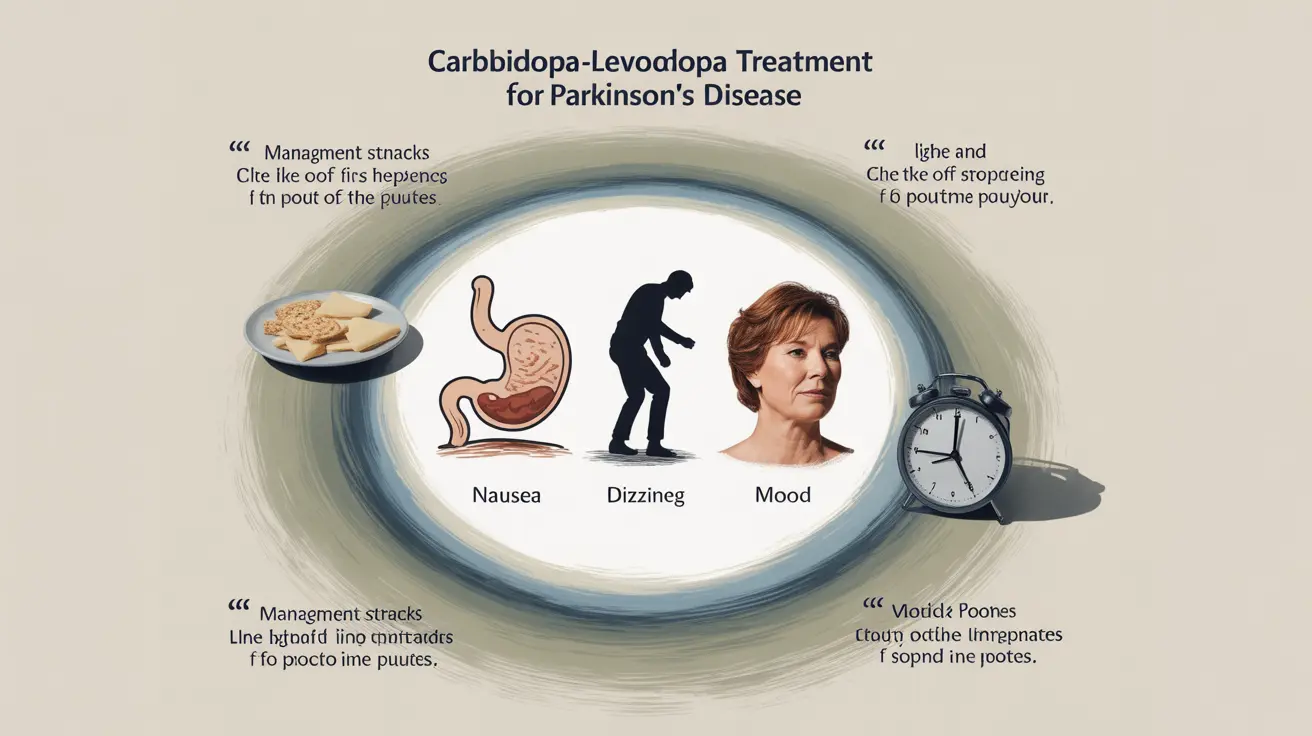Carbidopa-levodopa is a crucial medication for managing Parkinson's disease symptoms, but understanding and effectively handling its side effects is essential for optimal treatment outcomes. This comprehensive guide explores the common side effects of carbidopa-levodopa and provides practical strategies for managing them while maintaining treatment effectiveness.
Whether you're newly prescribed this medication or have been taking it for some time, knowing what to expect and how to respond to various side effects can significantly improve your treatment experience and quality of life.
Common Side Effects of Carbidopa-Levodopa
The most frequently reported side effects of carbidopa-levodopa include:
- Nausea and vomiting
- Dizziness and lightheadedness
- Loss of appetite
- Dry mouth
- Sleep disturbances
- Mild anxiety or restlessness
These side effects typically occur during the initial weeks of treatment or after dose adjustments. Most patients find that these effects become more manageable as their body adjusts to the medication.
Managing Nausea and Digestive Issues
Nausea is one of the most common initial side effects, but several strategies can help minimize this discomfort:
- Taking medication with a small, protein-free snack
- Avoiding lying down for at least 30 minutes after taking the medication
- Starting with a lower dose and gradually increasing it
- Using anti-nausea medications as prescribed by your healthcare provider
Addressing Movement-Related Side Effects
Managing Dyskinesia
Long-term use of carbidopa-levodopa can lead to dyskinesia (involuntary movements). Several approaches can help reduce this risk:
- Working with your healthcare provider to optimize medication timing
- Maintaining a consistent medication schedule
- Considering controlled-release formulations
- Regular monitoring and dose adjustments as needed
Dealing with "On-Off" Fluctuations
Some patients experience fluctuations in medication effectiveness, known as "on-off" phenomena. Managing these fluctuations may involve:
- Keeping a detailed symptom diary
- Adjusting medication timing and dosage with medical supervision
- Considering additional medications to smooth out responses
- Planning activities around medication timing
Monitoring Mental Health Effects
Carbidopa-levodopa can sometimes affect mood and cognition. Watch for:
- Changes in mood or behavior
- Visual hallucinations
- Confusion or disorientation
- Increased anxiety or depression
Early recognition and communication with healthcare providers are crucial for managing these effects effectively.
When to Seek Immediate Medical Attention
Certain side effects require prompt medical evaluation:
- Severe confusion or hallucinations
- Irregular heartbeat
- Severe dizziness or fainting
- Unusual chest pain
- Severe dyskinesia affecting daily activities
- Dark or red-colored urine
Frequently Asked Questions
What are the most common side effects of carbidopa-levodopa for Parkinson's disease?
The most common side effects include nausea, dizziness, loss of appetite, dry mouth, and mild anxiety. These effects typically improve as your body adjusts to the medication.
How can I manage nausea and dizziness caused by carbidopa-levodopa medication?
Take the medication with a light snack, avoid lying down after doses, and maintain proper hydration. Your doctor may also prescribe anti-nausea medication or adjust your dosing schedule.
What serious side effects should prompt immediate medical attention when taking carbidopa-levodopa?
Seek immediate medical attention for severe confusion, hallucinations, irregular heartbeat, severe dizziness, chest pain, or significant changes in movement control.
Can carbidopa-levodopa cause mood changes or hallucinations, and how are these managed?
Yes, mood changes and hallucinations can occur. Management typically involves dose adjustment, adding antipsychotic medications if necessary, and regular monitoring by healthcare providers.
Are there ways to reduce the risk of uncontrollable movements (dyskinesia) with long-term carbidopa-levodopa use?
Yes, strategies include careful dose titration, maintaining consistent medication timing, using controlled-release formulations, and regular monitoring with your healthcare provider to optimize treatment.
Remember to work closely with your healthcare team to develop an individualized plan for managing side effects while maintaining optimal symptom control.




